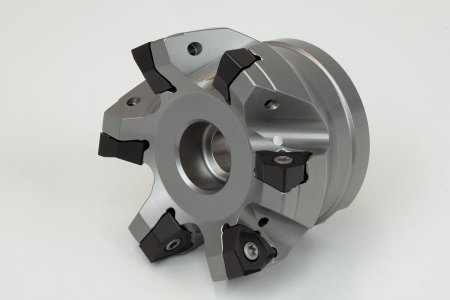- Joined
- Jun 12, 2014
- Messages
- 4,817
A 45 degree face mill will probably give a nicer finish in aluminum then the usual 90 degree, in addition the inserts can be rotated in 90 degree increments so you have 4 cutting edges vs. 2 for most 90 degree. There is also the forward rake of the insert pocket which takes less Hp. The other component is the insert, as there are different ones for ferrous vs. non-ferrous, as well as the type of steel. Aluminum typically uses ground edge inserts that are very sharp and are uncoated, ferrous inserts are almost always coated and the edges usually molded. There are many characteristics to the inserts and it can get complicated, but for most of us we usually have one set of inserts for aluminum and another set for ferrous.
Either a 2.0" or 2.5" would be OK in that size mill using a 45 degree face mill and lighter cuts, I would stay with a 2.0" if a 90 degree or primary work will be in steel. Surface finish on aluminum is greatly improved with some light lubrication/light air stream.
You need a R8 shell mill arbor for the size face mill you plan to get.

 latheinserts.com
latheinserts.com
Haas face mills are also recommended, I use them as well as a number of other people.
 www.haascnc.com
www.haascnc.com
 www.haascnc.com
www.haascnc.com
 www.haascnc.com
www.haascnc.com
I use this Haas face mill for both steel and aluminum and it can also do shouldering to a depth of ~0.3" I am only using the HS6NP, Carbide Shell Mill Insert, Trigon Negative Positive, Grade HMP20 for both and get a great finish. The inserts are trigons and can also be flipped so 6 cutting edges, and a pack of 10 inserts is two complete sets of inserts with a 5 pocket face mill. Haas is also running a sale on most of their cutting products through Friday.
 www.haascnc.com
www.haascnc.com
 www.haascnc.com
Optional if only aluminum
www.haascnc.com
Optional if only aluminum
 www.haascnc.com
www.haascnc.com

Either a 2.0" or 2.5" would be OK in that size mill using a 45 degree face mill and lighter cuts, I would stay with a 2.0" if a 90 degree or primary work will be in steel. Surface finish on aluminum is greatly improved with some light lubrication/light air stream.
You need a R8 shell mill arbor for the size face mill you plan to get.

45 DEGREE FACE MILL FOR ALL MATERIALS (SIZE: 2.5")
 latheinserts.com
latheinserts.com
Haas face mills are also recommended, I use them as well as a number of other people.
HSPP, 2-1/2" Ø Shell Mill, 3/4" Pilot Bore x 45° Lead Angle, 5 Flute, Positive/Positive Geometry
HSPP, 2-1/2" Diameter Shell Mill, 3/4" Pilot Bore x 45° Lead Angle, 5 Inserts (Square), Positive/Positive Geometry
HSPP, Carbide Shell Mill Insert, Square Positive Positive, Grade HN25 - Pack of 10
HSPP, Carbide Shell Mill Insert, Square Positive Positive, Grade HN25 - Pack of 10
HSPP, Carbide Shell Mill Insert, Square Positive Positive, Grade HMP20 - Pack of 10
HSPP, Carbide Shell Mill Insert, Square Positive Positive, Grade HMP20 - Pack of 10
I use this Haas face mill for both steel and aluminum and it can also do shouldering to a depth of ~0.3" I am only using the HS6NP, Carbide Shell Mill Insert, Trigon Negative Positive, Grade HMP20 for both and get a great finish. The inserts are trigons and can also be flipped so 6 cutting edges, and a pack of 10 inserts is two complete sets of inserts with a 5 pocket face mill. Haas is also running a sale on most of their cutting products through Friday.
HS6NP, 2-1/2" Ø Shell Mill, 3/4" Pilot Bore x 90° Lead Angle, 5 Flute, Negative/Positive Geometry, TSC
This Haas Square Shoulder 6 Negative Positive shell mill provides high stability and allows larger depths of cut for face milling and shoulder milling applications. It has a 2-1/2" cutting diameter, and a 3/4" pilot bore, with a 90-degree cutting edge. The cutter body takes 5 triangular cutting...
HS6NP, Carbide Shell Mill Insert, Trigon Negative Positive, Grade HMP20 - Pack of 10
HS6NP, Carbide Shell Mill Insert, Trigon Negative Positive, Grade HMP20 - Pack of 10
HS6NP, Carbide Shell Mill Insert, Trigon Negative Positive, Grade HN25 - Pack of 10
HS6NP, Carbide Shell Mill Insert, Trigon Negative Positive, Grade HN25 - Pack of 10





